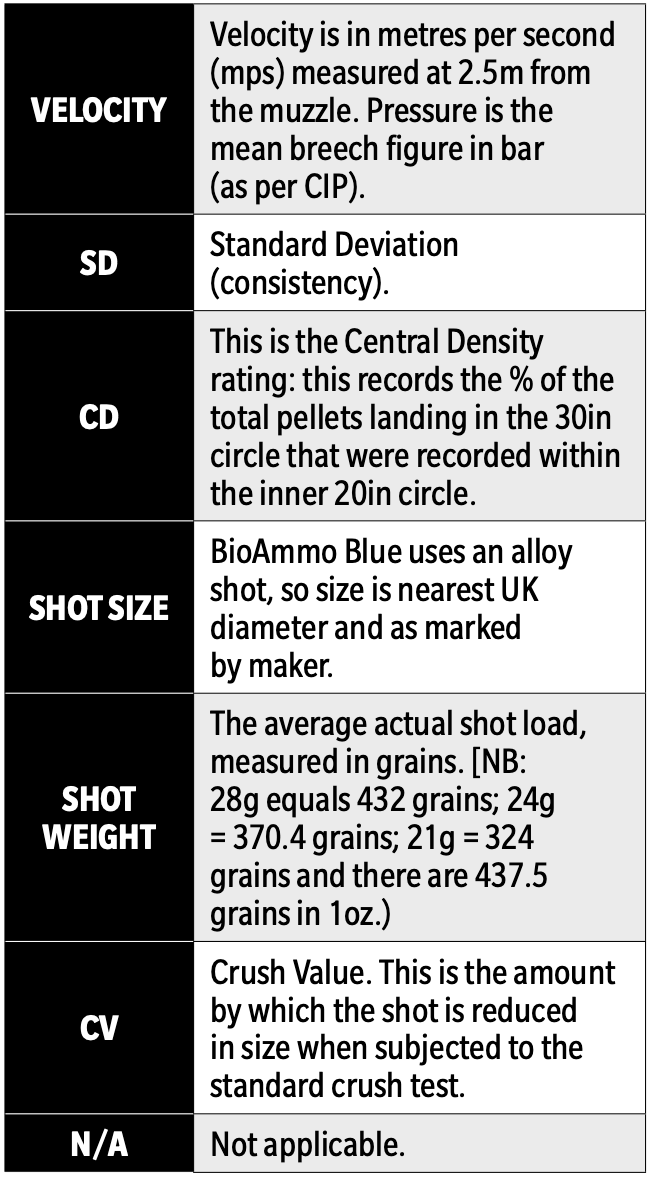Win CENS ProFlex DX5 earplugs worth £1,149 – enter here
BioAmmo’s non-toxic load
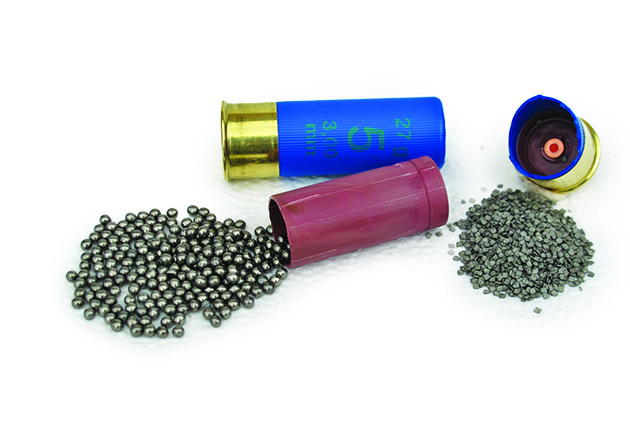 Bio Ammo Blue components
Bio Ammo Blue components
It is becoming increasingly evident how difficult the position cartridge companies have been plunged into is, following the rush to replace lead shot with non-toxic ammunition for game that enters the food chain. Note that nothing has actually been ‘banned’ as yet despite the language often heard when shooters discuss the topic. However, with members of the National Game Dealers Association expressing its intention to decline handling game shot with lead from 1 July 2022, well ahead of the ‘voluntary phasing out’ of lead shot over five years, it begins to feel more and more like a ban.
Cartridge companies have clearly been put in an invidious situation. Their work in developing a comprehensive range of ammunition for all types of shooting in all calibres has been done over 20, 30 and more years. But now key areas of their businesses are required to undergo rapid change. With the added issue of replacing the oil-derived HDPE wads with eco-friendly wads, the already hugely difficult task has become harder still to overcome.
The current shortage of some key basic components, such as primed cartridge cases, wads and propellant powders, with manufacturers affected by Covid lockdowns, plus material supply issues, increasing raw material costs and very high demand from the US, have all conspired to worsen the cartridge manufacturers’ position on non-toxic ammunition.
There is no magic non-toxic ammunition that behaves like lead shot at anywhere near comparable price. Steel shot is the front runner due to price, though also rising as the sudden increase in demand outstrips the capacity to supply. Now we have another option.

Components of BioAmmo’s Blue eco ammunition
A new non-toxic ammunition choice
The BioAmmo cartridge company has set its stall out very specifically around the eco-friendly concept. Having worked on biodegradable and compostable vegetal-origin biopolymers for several years, these are now used to manufacture the company’s cartridge cases and plastic wads used in its lead shot and non-toxic ammunition. The new BioAmmo Blue cartridges proclaim this ethos clearly on their packaging. Note that they biodegrade; in other words, they are broken down by bacteria in soil or compost. Composting will usually act faster than burying in soil. The biopolymers used are not affected by water as water-soluble polymers are.
We saw biopolymer wads and cases in the previous BioAmmo lead and steel loads. The wad used in the new Blue cartridges is of the same biopolymer but of different design. It is a fairly simple deep shot pouch with a gas seal skirt base. There is no cushioning centre section in order to make space for the bulkier (very accurately dispensed) special alloy shot load.
Plastic wad shot cups are usually divided into separate ‘petals’ intended to quickly open up on exit from the muzzle to ensure the wad falls away from the shot. Those intended for use with lead shot usually have moulded slits between the petals for ease and speed of manufacture. With harder shot, such as steel, where any pellet contact with barrel walls can be potentially damaging, wads often have knife-cut shot cups. This means there are virtually no gaps between shot cup petals where hard pellets might push through.
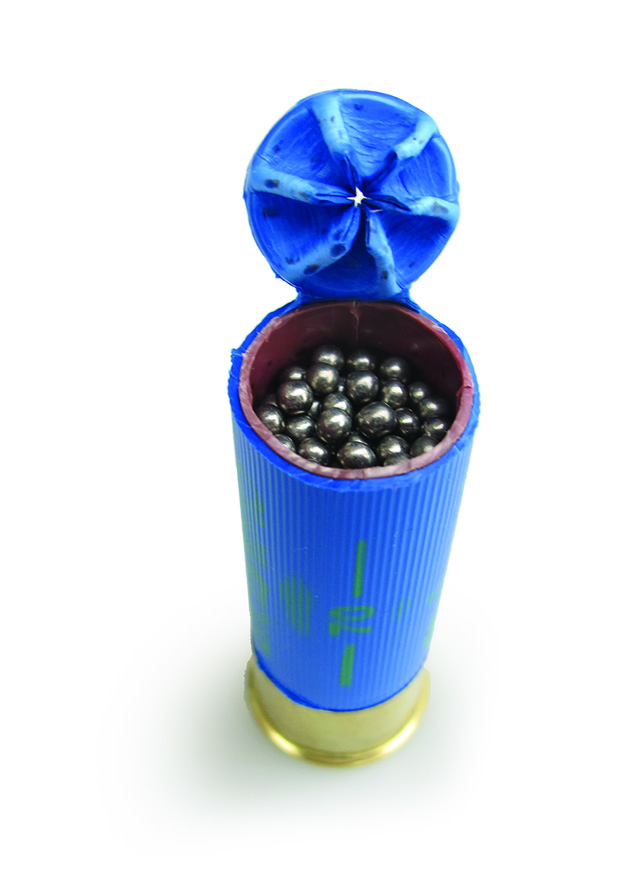
There is plenty of room in the wad for the shot load
The BioAmmo Blue wad has knife-cut slits to form the shot cup petals. These slits are 11mm deep, which is less than a third of the depth of the full shot cup. Given the strength of the biopolymer and thickness of the cup wall, it seems likely that the petals will not fully open up on muzzle exit. Examining fired examples showed this to be so. A high percentage hit the pattern plate, at 30 and 40 yards, either end or side first but never cup first.
The images of the fired wad cup mouths show this flaring. I suspect this results from the wad performing crimp-opening duties because the wad cup is slightly taller than the shot load. Most lead shot loads are the other way around, with the shot load as tall, or taller, than the wad cup; hence it is the shot load that usually opens the crimp upon firing, not the wad cup. This most likely also accounts for the ridge visible at the base of the shot cup of all the recovered fired wads.
Most importantly, the dimples clearly defined on the fired cup wads show that the pellets have been securely prevented from touching the barrel walls and with not so much as any ‘pin holes’ that steel shot can produce in some wads.
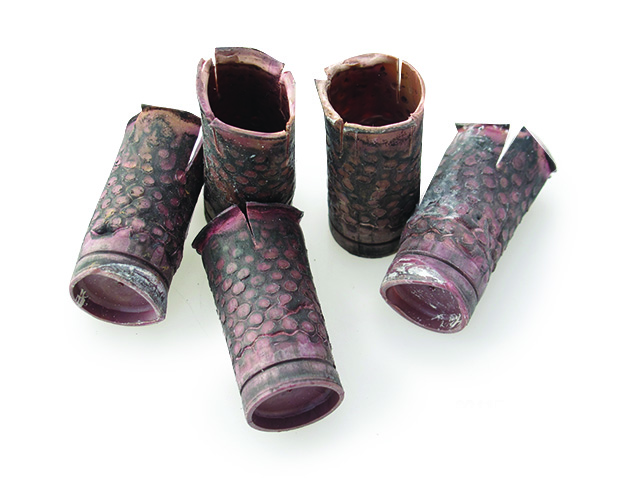
The sturdy biopolymer wads within BioAmmo’s Blue shotgun cartridges
It’s about the shot
Until BioAmmo Blue cartridges were launched, the main non-toxic ammunition load was its Rex line with steel shot. Blue launches a new type of shot that comprises an alloy mix of four metals: bismuth, tin, zinc and aluminium. (Read will my gun be safe with steel shot?)
With none of the ingredients being so dense as lead, the alloy pellets are obviously lighter, size for size, than lead. Some variation in shot size was evident when measuring samples, with the bulk falling between 0.106in and 0.120in. This gives an average size of 0.113in. The pellets were also rather less truly round than most lead shot pellets, varying from 0.008in to 0.016in out of round in the test sample. This makes precise size equivalent difficult but does fall within the UK No 5 and No 6 lead shot. This, I am assured, is a feature of the production process.
The crush test figures show the pellets are substantially harder than lead shot at around half the CV of the hardest lead shot of similar size. The pellets are substantially softer than steel, but we must assume that pellets are still best kept away from barrel walls.
The alloy pellets are bright silver in colour and have a smooth surface finish. No graphite, usually used in polishing lead shot, has been applied; the extra pellet hardness being sufficient to prevent pellets sticking together during the compressive acceleration forces generated on firing. Certainly there was no sign of pellet pairs in the patterns, which is easily recognised when it occurs with lead shot. It seems a complex alloy with four key ingredients but, presumably, this is to achieve the desired ballistic characteristics while remaining non-toxic. Bismuth alone can prove too brittle, as some early examples of bismuth cartridges were.
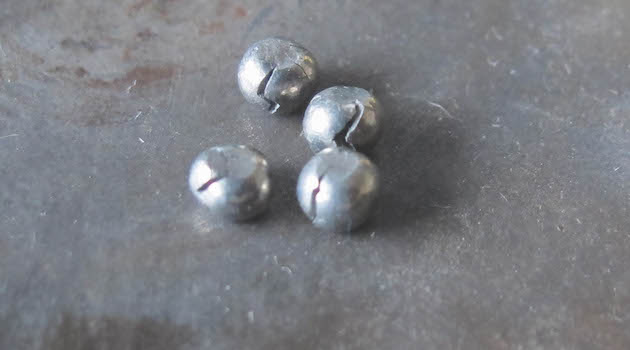
Most pellets cracked during crush testing for hardness
Crush test
While still brittle to a degree – the alloy pellets cracking when crush tested and shattering against the steel pattern plate – they did not shatter in the test chickens even when hitting bone. Some pellets embedded in the wooden box used to sit the test chickens on, also remaining intact. Whole pellets were also found intact inside the test chicken carcasses after penetrating the flesh. Distortion was minimal, so maximum diameter remained much as the original pellets. Any minor distortion was not easy to measure due to pellets not being truly round, as noted on the previous page.
In crush testing the shot, it was noted that the alloy is less ductile than lead, and this became evident with each pellet tested for hardness exhibiting a crack running from the centre outward. A couple of pellets fractured in the crush testing. This is most likely the result of the bismuth content of the alloy as this metal is known to be brittle. The other ingredients should, though, help ensure pellet integrity when striking the flesh/muscle of typical quarry. Pellets recovered from some test chicken carcasses bear this out.
Propellant
The propellant powder is a green/grey small square cut flake type. The actual specification is not divulged. It will have been specially selected, possibly specially blended, to work with the new wad and shot type and load weight, with the shot column height this combination involves as sectional density affects powder burning rate. Powder charges weighed an average of 28.6 grains, which is quite substantial for a 27g shot load. The powder burned very cleanly indeed in both the semi-auto and over-and-under guns used in testing.
These cartridges were tested at the Birmingham Proof Laboratory for ballistic performance. The pattern results in the table above are from a 30in barrel with fixed Imp Mod barrel at 40 yards. Additional testing at 30 and 40 yards was carried out with an Imp Cylinder choked barrel to check characteristics for this novel shot type, with results listed separately.
BioAmmo Blue are, as the proof report shows, quite fast. Achieving 418mps at 2.5m is no mean feat because the CIP sets a limit of 425mps velocity for this type of non-lead shot. Keeping close to the maximum so as to impart maximum energy to the lighter pellets can be tricky, given that shotgun cartridges seldom maintain the very tight velocity tolerances of centrefire ammunition. Trying to get too close to the limit can cause a batch to be unsaleable if velocity strays too far over the limit.
For such a brisk load, I found recoil quite manageable with my over-and-under. A lightweight side-by-side will naturally feel different but the 11N/s momentum is around that of many 30g lead shot loads.
Patterns
My 40-yard patterns proved a bit more open than anticipated, given the shot being harder than lead. I therefore tested at 30 yards with my Imp Mod (three-quarter) choke test barrel. To check if the shot might respond better with less choke, I also tested at 30 and 40 yards with an Improved Cylinder choke barrel, which is a common game gun choke.
Note that the trend to pattern more open than the choke remained with the more open choke boring. Particularly interesting is that the 30-yard pattern results are closer to the choke used than at 40 yards. It appears the patterns, from the two guns I used, begin to diverge more quickly as the range increased. This is a good indicator, but it may be as well to pattern test your gun to see how they behave with your chokes.
Shooting more open is not necessarily a bad thing, especially when a great many shoots from woodland rides and the edges of level ground woods and so on do not present the really tall birds some specialist shoots in Devon, Wales and Yorkshire can.
It is our responsibility as sportspersons to uphold the principles of respect for the quarry; this applies whichever live quarry is involved. This respect requires us to be the best shot we can be and use the appropriate equipment for the task in hand and to use our skill set and equipment, being aware of capabilities and limitations of both.
We are all faced with using different cartridges – and maybe new guns – to continue our sporting endeavours. Whether using steel shot, bismuth, some tungsten-based matrix, this BioAmmo Blue alloy shot or whatever new non-toxic ammunition alternatives may appear on the market, respect behoves us to familiarise ourselves with it before venturing into the field.
As can be seen from recent tests of steel shot cartridges and this new alloy, neither steel nor alloy shot performs the same way in the test guns as lead shot cartridges do. I hope we can all aim to be the best we can. This entails some study/research and familiarisation with the products on the pattern plate to discover how they perform in your gun and chokes. If possible, some testing on clay targets can be revealing – though not at a regular clay shooting ground without seeking permission first. I use my own clay trap for such purposes.
BioAmmo non-toxic ammunition in summary
These new cartridges are a welcome addition to the non-toxic ammunition choice emerging for game shooters. The alloy shot is a novel approach. We can see that, as with steel shot, the pellets are less dense than lead (10 Blue alloy pellets weighed 15.4 grains and 10 No 5 lead weighed 19.6 grains). The pellets must therefore be larger and launched at high velocity to retain sufficient energy downrange. Larger pellets meet more air resistance, so the larger size works against the velocity increase. It is only possible to maintain a sensible level of recoil if velocity levels are not overly high, notwithstanding the CIP limits imposed.
The BioAmmo Blue use pellets about as large and the velocity as high as current CIP limits allow. Penetration is important and, at 30 yards side-on to our test chicken, several pellets penetrated through over 50mm of flesh in parts to reach the cavity. Others penetrated as deep but were stopped at the breast bone. Fired breast-on from 25m, three pellets penetrated the breast meat and bone to reach the cavity. One had penetrated over 60mm, but this was through all muscle and no vital organ would have been struck by it.
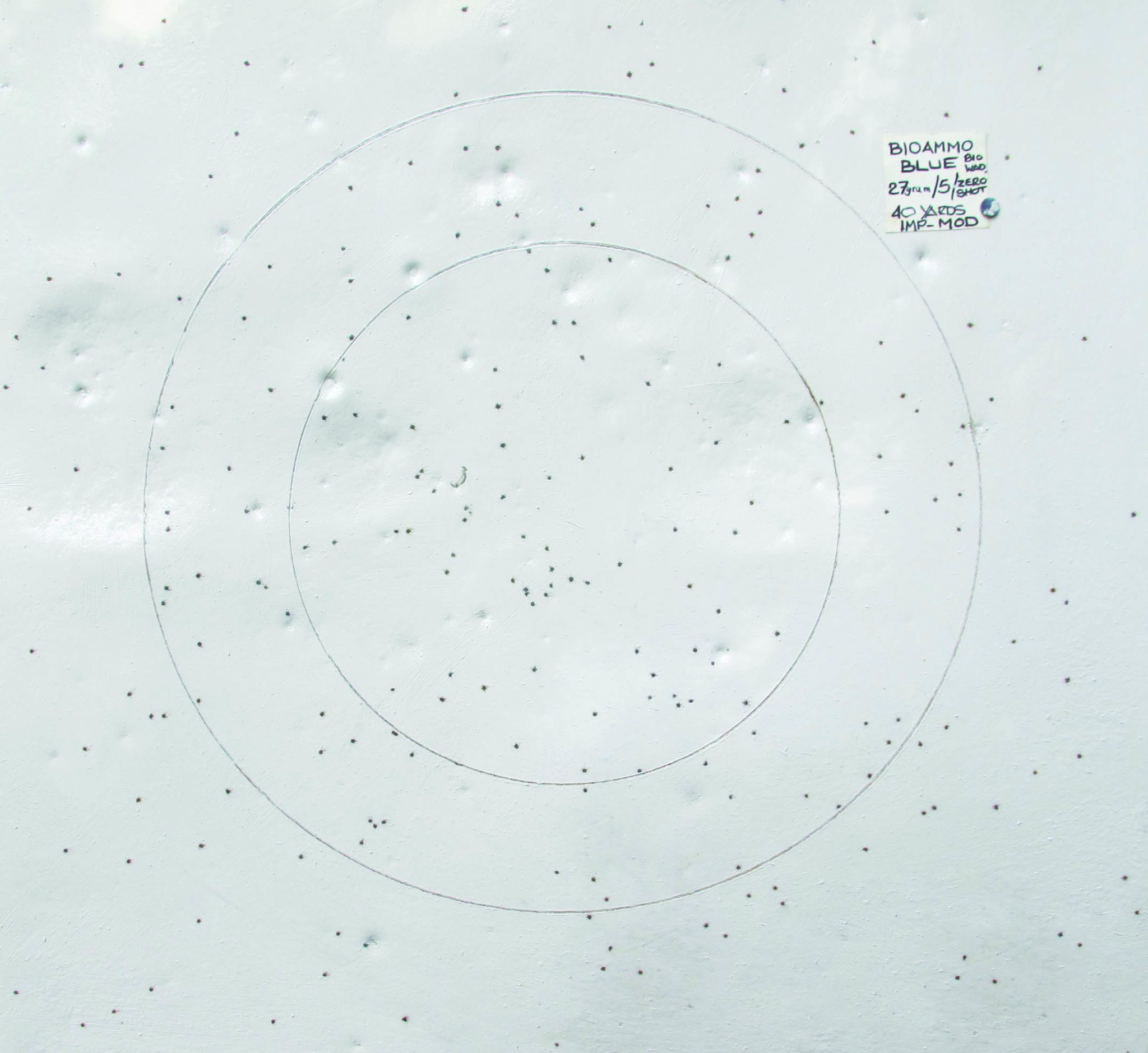
BioAmmo Blue Imp Mod at 40 yards
The 30m side-on penetration equalled that of a No 6 lead cartridge also tried, which surprised me a little.
As the patterns reveal, in the test guns patterns were dense at 30m then opened quickly beyond that. It therefore seems that somewhere around 35 and 40 yards is likely to be a realistic sporting maximum range, depending on quarry – for example, pheasant, duck or partridge – at least until we know more about them. Caution is the reasonable sporting approach. Some might think this a limitation, which it may well be: but a lot of game is taken at under 35 yards.
We are all seeking alternatives and BioAmmo is working hard to provide us with them. The current suggested retail price is £540/1,000. That is with ‘eco-friendly’ biopolymer wads and cases, as well as non-toxic ammunition shot. The best way to see if they suit you is to buy a few boxes and try them for yourself; you may be pleasantly surprised.
Tech specs
- Configuration BioAmmo 27g No 5 lead shot bio-plastic wad
- Shot load 420 grains
- Pellet (count per oz) 295
- UK shot (size/CV) 5/10%
- Pellets in 30in dia (Av) 143
- Pellets in 20in-30in 69
- Pattern 52%
- CD 52%
- Velocity 418m/s (1,374fps)
- SD 9.7
- Recoil (M) (Ns) 11.3 Ns
- Pressure (bar) 599 bar
Related Articles
Get the latest news delivered direct to your door
Subscribe to Shooting Times & Country
Discover the ultimate companion for field sports enthusiasts with Shooting Times & Country Magazine, the UK’s leading weekly publication that has been at the forefront of shooting culture since 1882. Subscribers gain access to expert tips, comprehensive gear reviews, seasonal advice and a vibrant community of like-minded shooters.
Save on shop price when you subscribe with weekly issues featuring in-depth articles on gundog training, exclusive member offers and access to the digital back issue library. A Shooting Times & Country subscription is more than a magazine, don’t just read about the countryside; immerse yourself in its most authoritative and engaging publication.






